Welcome back to the Commander Corner. I won’t bury the lead on this one: I want to talk about counters. No, not the +1/+1 variety, but actual Counterspell and its many variations from across the 30-year history that Magic: The Gathering has to offer. If you’ve ever wondered just how good counters are in Commander or which ones are worth playing, you’re in the right place.
Counterspells vs. Removal
There’s a lot of overlap between counterspells and removal, and you could almost call counters “pre-removal.” Much like single-target removal spells, counterspells usually deal with opposing cards on a one-for-one basis. I’ve previously expressed opinions about the declining power of removal, but let’s go over some advantages and drawbacks to counterspells.
Unlike removal spells, counterspells can completely prevent most cards getting any value whatsoever, which is especially relevant against cards that have powerful enters the battlefield abilities. Additionally, you can use counterspells to protect your own combos and cards, which is particularly relevant for synergistic or combo decks. However, unlike removal, you are reliant upon the spells being on the stack to use your counterspells. Counterspells often also make you choose between tapping mana on your own turn to develop your own strategy and holding up interaction.
Both counters and removal suffer from being inherently disadvantageous from a card-advantage perspective. While it might be great to stop a game-winning spell from resolving, you will generally be down a card compared to two or more of your opponents at the end of any exchange that wouldn’t end the game without your intervention. You can only be so down on cards before you’re losing most games—that’s just math. After all, how many counterspells are you happy to have in your opening hand? Too many and you risk having Squandered Resources while your three opponents are actually doing things.
Power Creep Makes Counterspells Worse
I’ve already touched on how card disadvantage can make counters a bit less tantalizing a proposition to some players but it’s not just a raw numbers game. There’s a lot of extra work that goes into analyzing why and how counterspells work in Commander, and I’m diving into at least a little bit of it today.
The term “power creep” generally refers to how, over time, Magic cards grow stronger compared to previous iterations of similar designs. Showing Ragavan, Nimble Pilferer to a player in 2010 would likely elicit either disbelief or outright laughter. While I think there are discussions to be had about power creep, the main takeaway is that cards are generally stronger now than they were just one decade ago.
This, in turn, makes counterspells worse. After all, why waste tempo trying to top three players from winning when you can spend it trying to win yourself? That said, counterspells are still quite powerful, so let’s take a look at some of the most relevant and commonly played ones in the format.
The Common Counterspells
Below are some of the most relevant, iconic, and common counterspells in Commander, and I’ll be discussing them individually before delivering a final grade to each one. My goal is to highlight the unique aspects of each one and provide context to their value in the format. Keep in mind that the competitiveness of a given table and your particular meta might shift these grades a bit, so take them with a grain of salt.

The original Counterspell itself is a wildly efficient spell by conventional standards, but like almost any other counterspell that you have to pay mana for, it has downsides. The biggest is that it costs two Blue mana, which doesn’t sound like much until you’re trying to cast other Blue spells in the same turn. Overall, however, it earns a solid B for being a classic role filler that generally trades up in terms of mana cost.
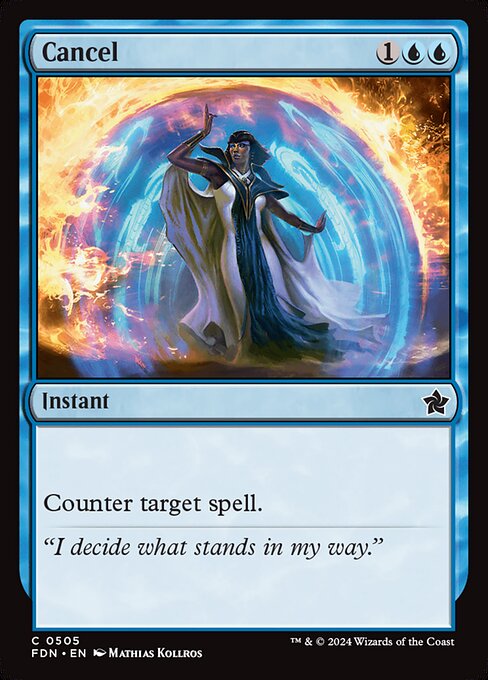
The modern template for how much an unrestricted Counterspell will cost, Cancel and its variants (Dissolve, etc) are markedly less efficient and generally much worse. Three mana is just too much, and it’s hard to argue for anything above a D for these. At least they can target any spell, regardless of type.
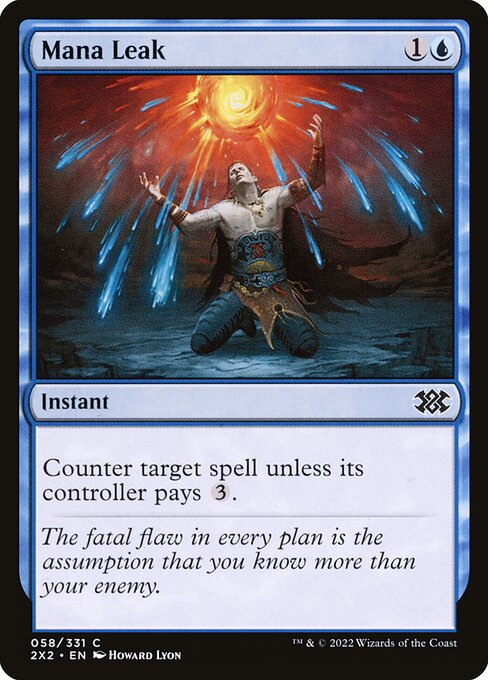
Cards like Mana Leak, Miscalculation, and others all share the fundamental flaw of being counterspells that get worse as the game goes longer, which is generally the opposite of what a conventional counter does. You don’t want to spend your whole turn in the early game casting these, and they are much more restricted in their use in the late game. Even so, their low cost combined with the nature of Commander as a format where people are casting huge spells lets them scrape by with a C-.
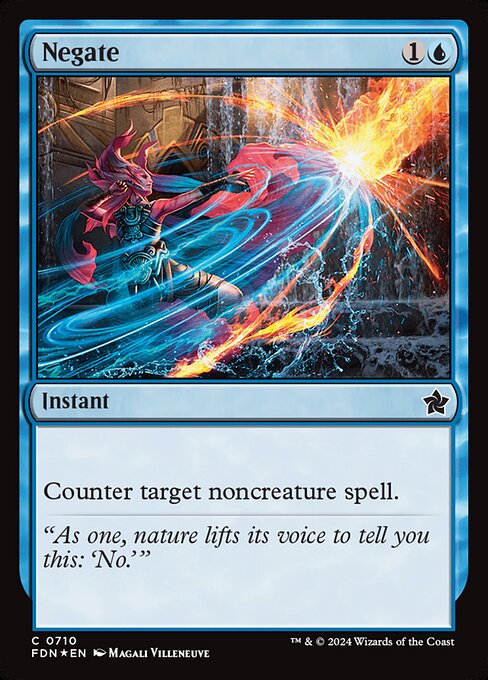
Any two-mana counterspell with only one Blue pip in its casting cost gets a big boost in my view, so I’m pretty fond of Negate and its variants. There’s always some number of powerful non-creature spells getting thrown around at Commander tables, and being able to shut those down with only two mana is like having a safety net underneath you during the mid-to-late game when it’s not difficult to leave that mana unspent. Negate-style cards generally earn a clean B, with hyper-efficient variants like An Offer You Can’t Refuse going up some amount.
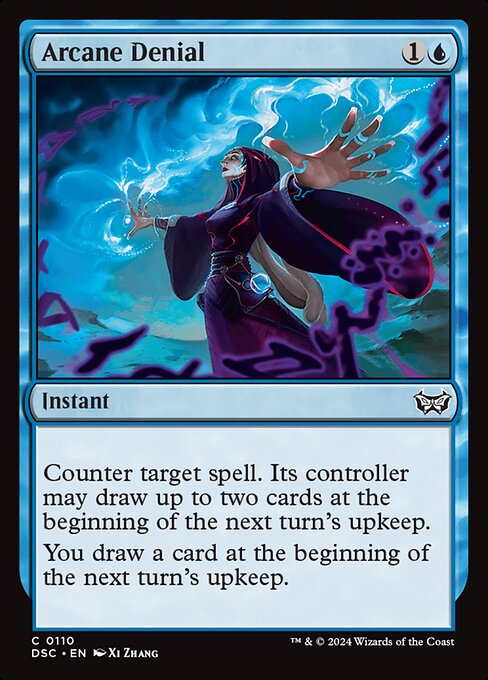
So many people have spent time trying to convince me that this card is bad, or at least worse than Counterspell, and it certainly isn’t either of those. It’s actually one of the better counterspells ever printed with regard to the Commander format—let me explain why.
In a vacuum, an average counterspell will trade for a single card, meaning that you and one other player are down a card compared to the other two opponents. Arcane Denial, on the other hand, leaves you down one card against only one player. Plus, players tend to get less salty if they get to draw two cards as a reward for not getting their spell. This is a clear A.

Counterspells tend to get much better if they have more utility beyond just countering a spell, and Mana Drain does quite a bit more most of the time. This card enables absurdly powerful plays with such frequency that everyone else at the table breathes a sigh of relief when the mana doesn’t get used. A+ for sure.

As far as free counterspells go, they don’t get too much more iconic than Force of Will. While you’re usually trading card efficiency for mana efficiency with “pitch” cards like this one, other free spells that we’ll cover later make this feel markedly less appealing. Despite this, FoW is still incredibly strong, and card inefficiency matters less if you’re capable of mass card draw. All this together earns FoW an A.

This is the cream of the crop for free spells in casual Commander. It’s no more card inefficient than most conventional Negate variants while also having the benefit of usually costing zero mana. You can use it offensively or defensively, which I firmly believe is a mistake in design, and noncreature spells are only getting more powerful over time. If nothing else, it’s a get-out-of-jail-free card if your Commander gets targeted with removal that doubles as a marginally inefficient three-mana negate, which earns this an S+ alongside the honorable mention Deflecting Swat.
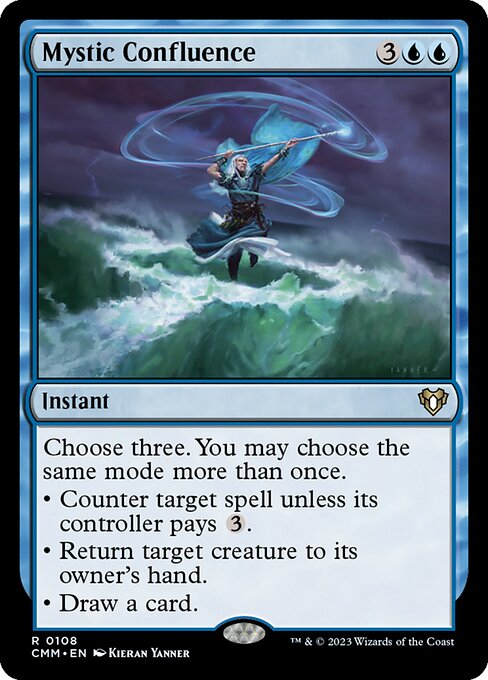
It might seem odd that I’m about to praise a five-mana counterspell, but the versatility and power level of Mystic Confluence on complex boards make up for what it lacks in mana efficiency. If you’re already playing a lot of spells when it isn’t your turn, this is a great way to get extra value out of a counterspell. This card has constantly overperformed for me in reactive decks, and the only downside is the high mana cost. I’ll be giving this a very biased B-.
In Response…
I’ve talked at length about a wide variety of counterspells, but when to play them is just as important as which ones are best. Your deck will be worse if you simply jam the best counterspells into it without knowing why or considering your gameplan. Some decks, for instance, do not want to play the actual card Counterspell at all. Other decks want to load up on as much free interaction as possible. Finding your balance is the key.
The best deck in my collection contains only three counterspells, and prefers to use proactive plays to push the game forward than to sit back and wait. I hope you have gleaned something from this conversation. If you have experience with some or all of these cards it might not seem groundbreaking, but for some players might benefit from added direction. At any rate, that’s all I have for you today. I’ve been Luka “Robot” Sharaska, and this has been the Commander Corner.
Luka V. Sharaska (they/them) earned the nickname “Robot” by having a monotone voice, a talent for calculating odds, and a perfect poker face. Robot has been playing Magic for more than a decade, starting during the days of New Phyrexia in 2011.

